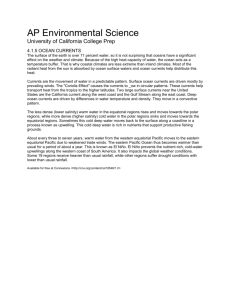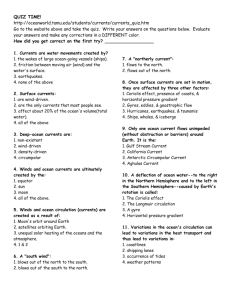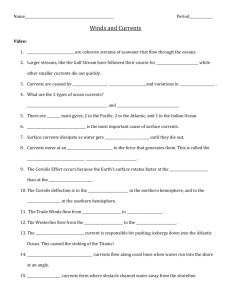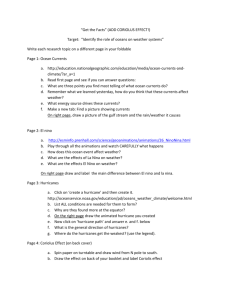Currents and Climate 2011 student
advertisement
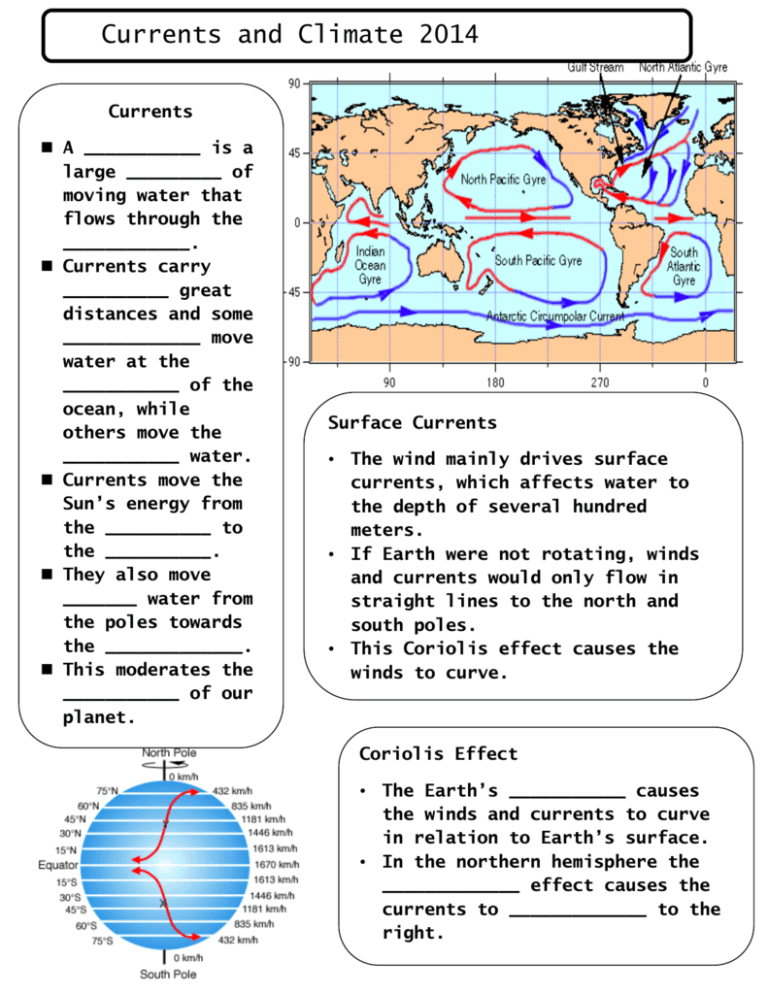
Currents and Climate 2014 Currents A ___________ is a large _________ of moving water that flows through the ____________. Currents carry __________ great distances and some _____________ move water at the ___________ of the ocean, while others move the ___________ water. Currents move the Sun’s energy from the __________ to the __________. They also move _______ water from the poles towards the _____________. This moderates the ___________ of our planet. Surface Currents • The wind mainly drives surface currents, which affects water to the depth of several hundred meters. • If Earth were not rotating, winds and currents would only flow in straight lines to the north and south poles. • This Coriolis effect causes the winds to curve. • . Coriolis Effect • The Earth’s ___________ causes the winds and currents to curve in relation to Earth’s surface. • In the northern hemisphere the _____________ effect causes the currents to _____________ to the right. The Gulf Stream The ___________ and most ___________ surface current is the _______ __________ in the North Atlantic Ocean. It is caused by strong _____ from the __________. The Gulf Stream carries ____ __________ from the Gulf of Mexico to the Caribbean Sea, then northward along the coast of the United States. This current keeps Northern Europe much ____________ in the winter than it would otherwise be. Deep Currents How Surface Currents affect Climate Climate is a _____________ of ______________ and ________________, typical for an area over a long period of _. Currents affect the climate by moving cold and warm water around the globe. A surface current warms or cools the air above it, _______________ the climate of the land near the coast. Stream like movements of ocean water located far below the surface are called deep currents. ________ ___________ are not controlled by _______. Deep currents form in parts of the ocean where water density increases. The density of the ocean is affected by temperature and salinity. Deep currents are caused by changes in _____________. Deep Currents continued Formation and Movement of Deep Currents: Differences in water ____________ cause variations in the movement of deep currents. Thick metal hulls protect Surface Currents and Climate Upwelling _____________ is the movement of deep, cold, and nutrient-rich water to the surface of the ____________. Nutrients that are brought to the surface support the growth of plankton. Plankton support larger organisms, such as fish and seabirds. Warm-Water Currents and Climate: Warm-water ___________ create warmer climates in coastal areas that would otherwise be much ____________. Cold-Water Currents and Climate: Cold-water currents keep ___________ along a coast cooler than the inland climate yearround. Nature’s Climate Change El Nino is an abnormal climate event that occurs every two to seven years in the _____________ Ocean. It begins when an unusual pattern of winds form over the western Pacific. This causes fast sheets of warm water to move eastward to the South American coast. It can last one to two years. Last one was from mid 2009 to early 2010. El Niño El Niño - is the warming of water in the Pacific Ocean. _________ and ___________ along the Pacific coast Warm water disrupts food chain of fish, birds, and sea mammals ___________ and _________________ in southern US Fewer than normal hurricanes in the _____________ More El Niño El Niño is a change in the water temperature in the Pacific Ocean that produces a warm current. Effects of El Niño El Niño alters weather patterns enough to cause disasters, including flash floods, mudslides, and droughts. El Niño also prevents upwelling off the coast of South America. El Niño Effects on Us! El Nino causes shifts in weather patterns around the world, bringing severe conditions to different areas. El Nino caused an unusually warm winter in northeastern U.S. It also brought heavy rains, flooding, and mud slides in California. It also brought a string of deadly tornadoes in Florida. . La Niña La Niña - is the cooling of water in the Pacific Ocean. Snow and rain on the ______ coast Unusually cold weather in Alaska Unusually warm weather in the rest of the USA Drought in the southwest Higher than normal number of hurricanes in the Atlantic Predicting El Niño Studying and Predicting El Niño: Learning as much as possible about El Niño is important because of its effects on organisms and land. To study El Niño, scientist use a network of buoys located along the equator. The buoys collect data about surface temperature, air temperature, currents, and wind.

